As a child, I was always fascinated by the ocean and marine life, especially whales and dolphins. I grew up in Walnut Creek, CA, a few hours from the coast. My mother shared her love for the ocean and made sure her children spent lots of time at the beach. Weekends often included shoreline picnicking.
When I was 12 we went whale watching in Monterey Bay, one of the best whale watching spots in the world. I fell hopelessly in love. There’s nothing like seeing a majestic whale in the ocean, hearing the sound of the blow and watching the back and tail coming up and out of the water before the whale dives.
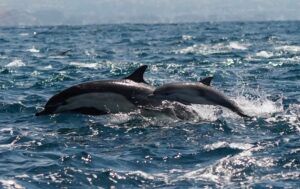
Dolphins Swimming Free in their natural habitat
I also loved watching the smaller dolphins, their streamlined bodies riding currents around the bow of our boat, quick puffs as they surfaced to breathe and do acrobatic jumps out of the water.
Knowing my love of dolphins, my parents decided to take me to San Diego’s Sea World. I was excited to see the dolphins up close, but something was wrong – wrong and heartbreaking.
It felt wrong to see them in small, concrete tanks or entertaining people with ridiculous tricks like “kissing” a lucky volunteer. Other tricks were bad, too –– shaking their heads up and down in response to questions asked by the trainer, doing headstands in the water so they could “wave goodbye” to the audience with their tails. It was especially heartbreaking after seeing dolphins swimming side by side with their families in the ocean, jumping for joy, not for a fish reward.
I learned more and more about threats facing whales and dolphins. I read about whaling and couldn’t believe humans almost wiped out the great whales.
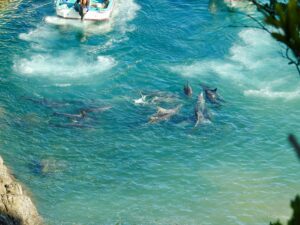
Bottlenose dolphins pursued into capture cove
Then I learned about the thousands of dolphins being killed by the tuna industry and I wanted to do something. So at 14, I joined Greenpeace.
My supportive mother helped me make copies of a flyer asking people to boycott canned tuna due to the dolphin deaths associated with tuna fishing. My mother dropped me off in front of the local grocery store and I stood in front for hours, handing out flyers and asking people not to buy canned tuna. I even taped the flyer to the canned tuna section of the store.
Thus began my life as an activist fighting for animals.
Now, at 62 and retired since 2023 as a marine biology/general biology teacher, I’ve had more time to focus on my passion.
In the decade before, my commitment got really focused after learning about the slaughter of dolphins in Japan. I was horrified but it hurt to know more. Then I watched “The Cove,” which won an Academy Award in 2010 for Best Documentary.
The film followed former-dolphin-trainer-turned-activist Ric O’Barry and I saw the final scene of dolphins brutally slaughtered in the cove in Taiji, Japan. I couldn’t believe it. Humans were still brutally slaughtering dolphins in 2010?
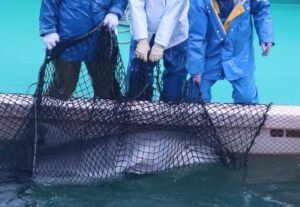
Bottlenose dolphin captured
I had to help end these slaughters.
So I began to volunteer with Ric O’Barry’s Dolphin Project to end these hunts. The main source of profit from the dolphin drive hunts is capturing live dolphins, training them and selling them to captive facilities.
After one of my class presentations as a teacher about the dolphin slaughter, a student asked if I had ever been to Taiji and seen the hunts. I knew then that I had to go to witness firsthand what I was talking about.
So at 51 years old, I bought a ticket to Japan.
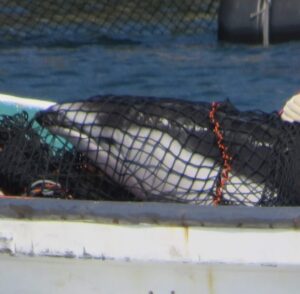
Captured Pacific White-Sided Dolphin
It was the first of 12 yearly trips to Taiji I’ve made to document the dolphin drive hunts. After witnessing my first slaughter in person, I made a promise to the dolphins of Taiji that I would do everything to help end the cruel and brutal hunts. I convinced my high school to offer Marine Biology so I could teach to my passion. The school supported me by allowing me to take two weeks off at Thanksgiving, which gave me three weeks in Taiji.
In 2017 I took a travel sabbatical to document the suffering of the animals because I strongly believe a key to ending the hunts is reducing the demand for captive dolphins.
I’m now the Educational Outreach Coordinator for the Dolphin Project and I make classroom presentations to help students with dolphin-related projects.
I want to empower children to make educated decisions as to whether they want to support dolphin captivity or not.
Exposing the cruelty behind dolphin captivity and how it is linked to the slaughters is one of the best ways to get people to stop supporting the industry. Don’t go to dolphin shows. Don’t swim with captive dolphins. Most people are naturally compassionate and sympathetic to the plight of captive dolphins once exposed to the truth behind the dolphin smile.
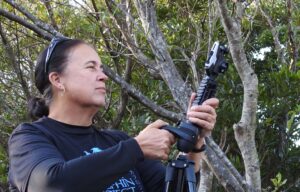
Filming
I have spoken to students from third grade to law school students at an Animal Rights symposium. I use photography videography and social media to raise awareness.
I made a film, “A Tale of Two Risso’s” about Risso’s dolphins living near the coast of Japan versus those living close to Monterey, CA. I won an award for Best New Filmmaker at the 2023 Dana Point Film Festival.
I continue to travel to Taiji and continue to document and raise awareness about the hunts. My retirement gives me time to take better care of myself and get healthier but my main motivation is to stay strong enough to be able to travel to Japan, to continue to climb that steep hill that overlooks the cove, and be a voice for the dolphins.
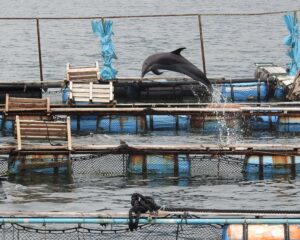
Captive bottlenose dolphin
The hardest part is often being unable to help the dolphins in Japan. The hunts are legal and well-protected by the police. When I’m in Taiji, I can only document but when I am not in Japan, I raise my voice, strong and loud for the dolphins. I’ve seen dolphins wrestled away from their families and carried off for a life in captivity, dolphins trapped in nets, struggling to breathe before being dragged off to slaughter. I’ve witnessed dolphins trying to protect each other from the onslaught of humans, mothers trying to protect their calves, mothers and calves ripped apart from each other and countless other heartbreaking scenes.
I believe the proverb, “It’s better to light one candle than curse the darkness.” I try to light as many candles as possible about this issue.
I’m told having a passion and purpose as I continue to age gives me better mental health and more reasons to stay strong and healthy. I want to stay in the fight! I have to keep myself mentally sharp and physically strong. Each time I travel to Taiji, I bring a wealth of information learned by experience and share it with the younger activists. I learned a great deal from Ric O’Barry and others who traveled to Taiji before me. The knowledge and wisdom accumulated with age and experiences is priceless.
Through volunteering with Dolphin Project, I feel purpose, peace and contentment. I’ve tried to make a difference, tried to make the world a better place, especially for the dolphins of Taiji. I have a promise to keep –– for myself, for the dolphins and for my mother.
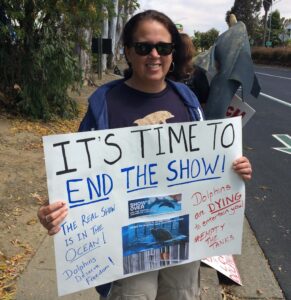
Protesting
Marine life is my passion, especially whales and dolphins. I am a former high school marine biology teacher and currently the education outreach coordinator and a veteran Cove Monitor for Dolphin Project. My focus is on whale and dolphin conservation and teaching the next generation to care for the ocean.

Such a courageous and committed life. Thank you for sharing her story.
Wow, Cynthia. I’ve known you as a friend, caretaker and companion of older dogs. Now I know more about your story. My grandmother told me that if I ever was in an earthquake or some other catastrophe, to look for the helpers. There will always be helpers, she said. You are one of the helpers. Thank you.
Such commitment to know as a teenager this was your life’s work.
What you’re doing is wonderful and necessary. I’ve never been interested or willing to see animals in captivity and when I was young and taken to the zoo I cried. I couldn’t bear to see the lions and tigers stalking in a concrete barren cage. Your work and teaching helps to create a consciousness in people and that matters. Thank you for all you do.
Nancy
Cynthia, thank you for sharing this powerful and remarkable story! Your dedication and advocacy for these beautiful dolphins is truly inspiring.
Very powerful story. You are living a very worthwhile life.